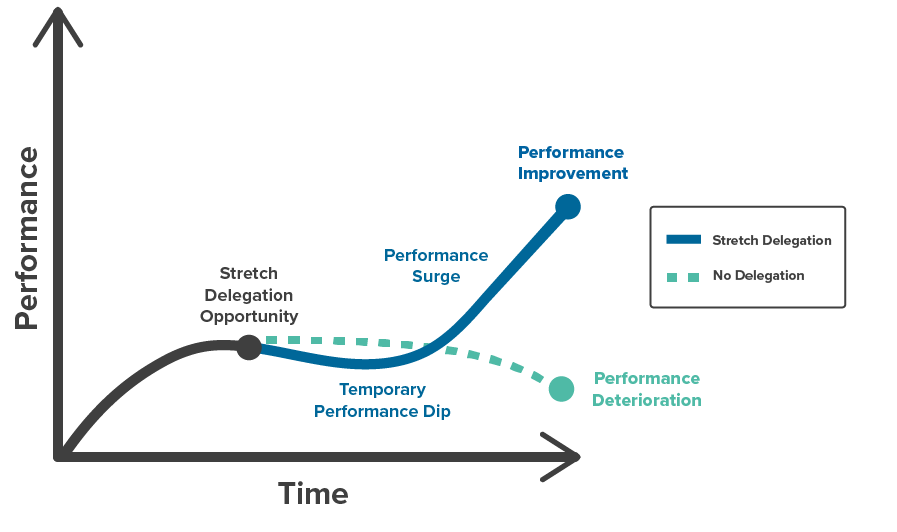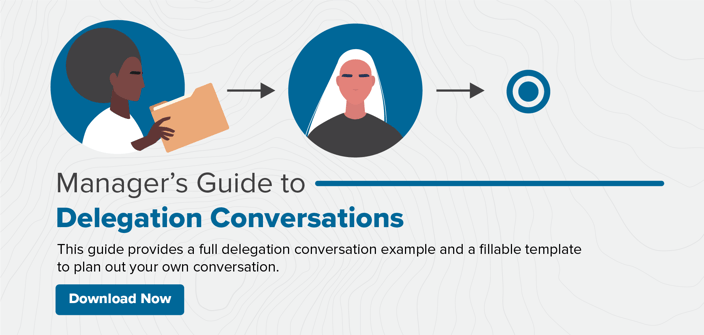IA Insights > Blog
Stop Stressing, Start Delegating
How are you currently feeling at work? Overworked, stressed, and constantly feeling that you’re behind? For many, this is considered just another day as a manager.
If you feel this way, take a moment and review your current to-do list. How many items are you doing because you think you’re the only one that can accomplish it? It’s likely that there are a few tasks that someone else is perfectly capable of doing. It’s time to consider delegating those tasks. In this blog, we’ll cover why managers have a difficult time delegating, a specific type of delegation designed to boost long-term employee development and performance, and how to set it up correctly.
Delegation is a skill that every manager should strive to do well and frequently yet so many struggle to achieve. According to a Forbes article, only 30% of managers believe they are good at delegating and only a third of them are considered good delegators by their own team. This equates to only 10% of managers that are considered really skilled at delegation. Speaking for myself, this is one skill that’s taken many years to develop, and I still have to remind myself to do it. Why is the act of handing off work to someone else so difficult?
The most common reason why managers don’t delegate is that they feel they can complete a task much quicker than it would take to teach another person. While this may be true, it’s hurting managers in the long run. When managers decide to take on these tasks themselves, they continue racking up hours of time that could be used elsewhere on more important tasks. Because managers aren’t giving new, challenging assignments to staff, this minimizes opportunities for staff development, holding back the overall team skillset and allowing a risk for staff turnover.
Enter stretch delegation.
Stretch delegation is when an employee is asked to perform in a new or unfamiliar territory. It is a practice used by managers to get more work done in the short term and build employee capability and commitment for the long term.
The below graphic depicts how stretch delegation works using the factors of “time” and “performance”. The blue line symbolizes a stretch delegation assignment. While the time it takes for the new assignment to be completed by the employee is often longer and may even encounter a slight performance dip initially, the long-term performance of the employee is much greater than if they had been given no such assignment.

Factors to Consider before Delegating
Before deciding to delegate a task and who you’ll delegate to, you should understand the risks and benefits associated with this delegation decision. In one of our flagship programs designed for first-time people managers, Managing with Impact, we dive deeper into types of questions a manager should consider before delegating. Below are a sample we’ll focus on in this blog.
Employee Capability & Motivation
- What knowledge and skills has the employee demonstrated that make them the right person for this task?
- What sort of motivation will this employee have to work on this task?
It’s important to think of what interests they have in career development. If this task aligns with future goals and existing skills, it’ll not only motivate them to do well, but shows them that you value their development within the organization.
Importance & Risks
How significant is this task in relation to your group or organization objectives? Sometimes, delegation is not the solution. If the task has significant risks, consider a sort of shadow approach. Work on the task together and ensure they understand how it’s completed successfully so you can continue developing the skills associated with this task so they can take ownership of it in the future.
Bench Strength
Will the skills the employee develops by doing this task shore up a gap in your team or the organization’s skillset? A leading issue many organizations are facing is lack of bench strength and issues of overall staff retention. Use delegation as an opportunity to grow skillsets among others in your organization that will pay off in the long run by developing future leaders.
Availability
How much time do you and the employee have to work on this task? If the employee is too busy for this task, you’ll want to either have a prioritization conversation or consider someone else for the task. If you are too busy, you’ll also want to consider prioritizing your own tasks.
The Delegation Conversation
Once you’ve determined who you’ll be delegating a task to, it’s time to have the stretch delegation conversation. Note that many managers try to communicate stretch delegation assignments via email. This approach rarely works. It’s best to have a live interaction where you can outline the assignment, ask questions, and confirm understanding – the key building blocks of building an agreement. Have a conversational game plan that includes the setup of the conversation, engagement of the delegation conversation, and completion on moving to next steps.
- Set Up
- Confirm the desired outcomes of your delegation conversation:
- Explain the big picture and impact of this task:
- Engage
- Explain why this employee was selected
- Describe the expectations and parameters of the task
- Provide resources and an open line of communication
- Complete
- Acknowledge the summary of the agreements you’ve made
- Review the next steps for this task
If you’re feeling that you’re spread too thin or there aren’t enough hours in the day, it’s time to look at what you can delegate to others. When done correctly, delegation gives managers time back in their day to focus on other areas, builds confidence and commitment in employees, and helps build valuable skillsets in individuals that will grow an organization’s bench strength.
Looking to build greater delegation skills in your workforce? Consider Managing with Impact, a flagship program designed for helping managers tackle three critical managerial conversations (delegation, problem-solving, giving performance feedback) so they can feel more confident in their role and thrive.






